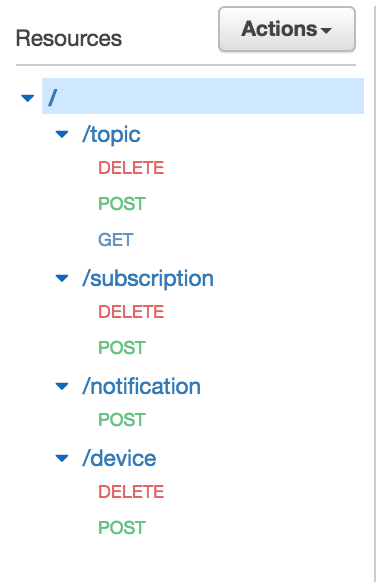Architecting Serverless Push Notification System in AWS Wed, Aug 31, 2016

Recently at Mindvalley we have decided to use one of the available solutions to send push notifications to our web and mobile users. The new service should support following requirements;
- Integrable with our user management system
- Authentication and Authorization with Auth0
- Send notification to user (multiple devices, multiple platform) not only single device
- Schedule notification
- Flexible user segmentation
- Comprehensive API to manage notification system
Proposed Solution
After doing some research and comparing aforementioned solutions I came up with the idea of using server less approach. The proposed system used AWS SNS, RDS, Lambda, and API Gateway to fulfill all requirements.

you can find all lambdas of the system here lets look at each step of implementing the solution;
Step 1: Design Database
I have decided to use RDS (postgresql) to store the system data. System’s DB contains 4 tables;
users_endpoints
internal_user_id : connects the system with user management system.
arn : Amazon Resource Name you get this value after registering the device in SNS.
token : user device token.
app_name : application name.
user_data : it is a dictionary, you can store any data for user and query them later based on given attributes.
timezone : to send notification in user timezone.
topics
stores topics which user may want to subscribe to them.
subscriptions
stores user’s subscription information
notification
stores scheduled notifications

Step 2: Implement Lambdas
Before you start uploading and deploying lambdas I suggest to read Configure your Lambda functions like a champ and let your code sail smoothly to Production post. It explains how setup your lambdas properly in test, stg, and production environments.
Step 2.1: Lambdas Configuration
We can store our configuration in AWS S3 ,dynamo db or in deployment package. configuration contains information about list of applications setup on SNS and RDS configuration for each environment.
{
"$LATEST": {
"APPLICATIONS": {
"appname-ios-dev": "arn:aws:sns:us-east-1:xxxxxxxxxx:app/APNS_SANDBOX/ios-dev"
},
"DATABASE": {
"host": "dev-sns-lambda.xxxxxxxxxx.us-east-1.rds.amazonaws.com",
"port": 5432,
"db": "xxxxxxxxxx",
"tables": {
"users_endpoints": "users_endpoints",
"topics": "topics",
"subscriptions":"subscriptions",
"notifications":"notifications"
},
"user": "xxxxxxxxxx",
"password": "xxxxxxxxxxxxxxxxxx"
}
},
"DEV": {
},
"TEST": {
},
"PROD": {
}
}
Step 2.2: Lambdas
As mentioned earlier, we need to implement 9 lambdas for user, device, subscription, and notification management. you can add or update any of given function to support your requirements. you can download all lambdas from here.
Step 3: API Gateway
After deploying and testing all lambdas now it is time to add API gateway as a trigger. After creating the API in API Gateway console, we need to add four resources and for each resource we need to add corespondent method;

Step 4: Send Scheduled notification
You may figure it out by now that there is one lambda handel_notification_cron which is not connected to any end point.
For this lambda we need to add CloudWatch Events - Schedule trigger. This trigger enable us to have a cron job and call lambdas every few
minutes to send scheduled notifications.
Step 5: Security
There are three techniques to secure your APIs. The simplest way is using api-key you can simply add new api-key in API Gateway console and enforce APIs to use it. The second method is adding Authorizers, it allows developers to authorize their APIs using bearer token authorization strategies, such as OAuth using an AWS Lambda function. And third method is using AWS_IAM role which is explained in detail on this tutorial.
conclusion
AWS Lambdas makes you able to build and run applications on the AWS cloud quickly and easily. On the other hand, existence of many great services in different domains help developers to solve complex problems in short amount of time.